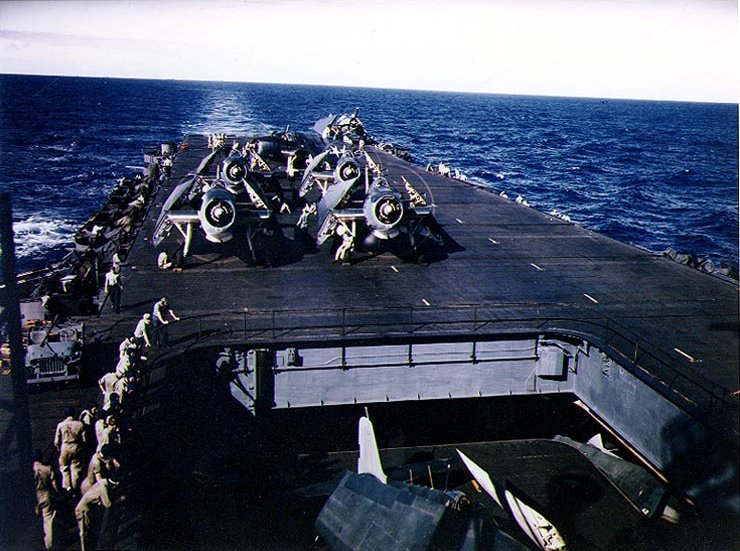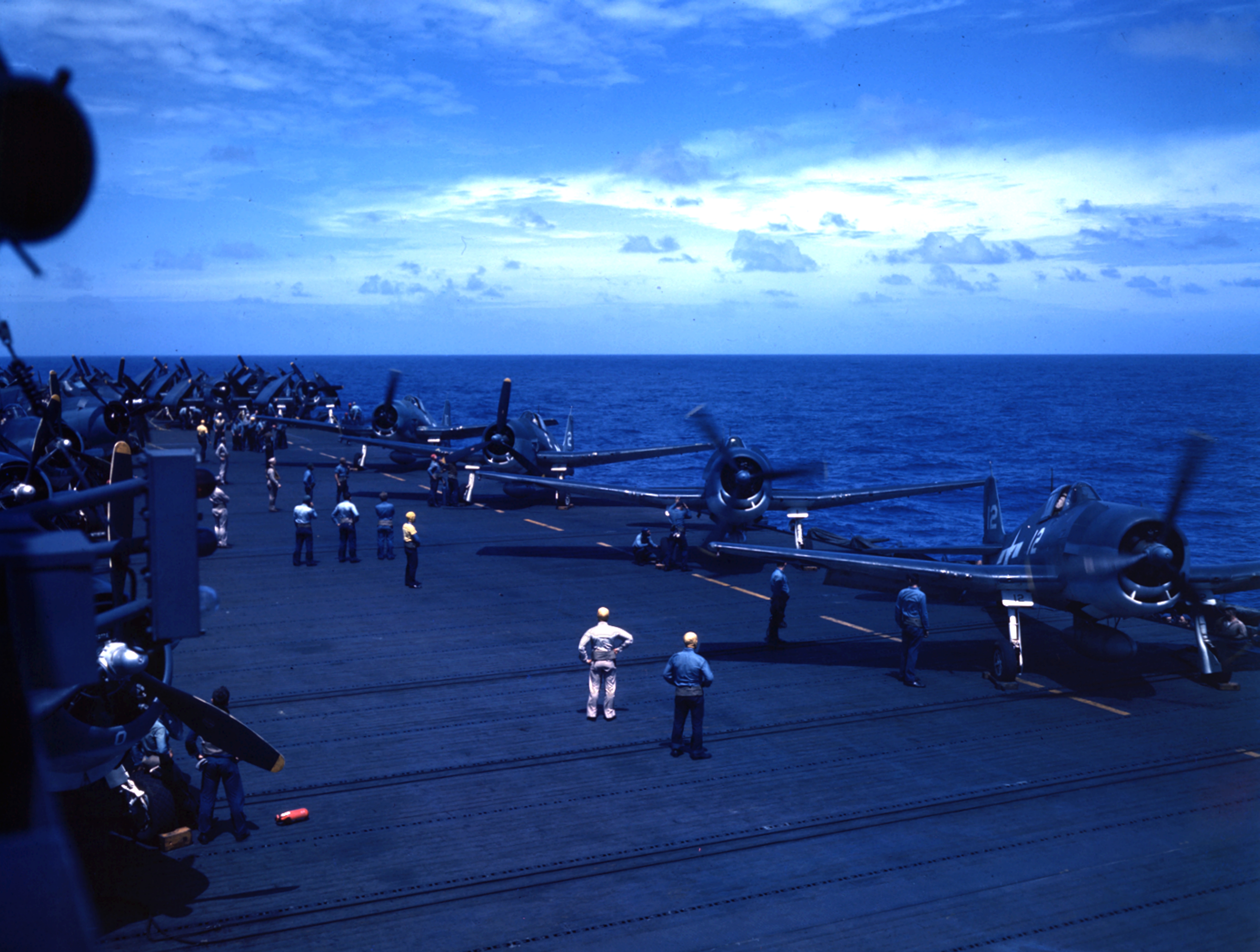| Second World War at Sea:
Carrier Operations, Part One
By Robin Rathbun
March 2023
 The aircraft carrier with its attached airwing is the undisputed queen of the seas in Second World War at Sea. It’s the only asset that can provide firepower beyond its own sea zone, or air cover outside the range of land-based aircraft. The CV is a necessity in a war where air power is required for any naval operation to succeed. In narrow waters like the Mediterranean and North Sea, land-based air can substitute, but aircraft carriers are an absolute must for operations in the open oceans. The aircraft carrier with its attached airwing is the undisputed queen of the seas in Second World War at Sea. It’s the only asset that can provide firepower beyond its own sea zone, or air cover outside the range of land-based aircraft. The CV is a necessity in a war where air power is required for any naval operation to succeed. In narrow waters like the Mediterranean and North Sea, land-based air can substitute, but aircraft carriers are an absolute must for operations in the open oceans.
Pioneered by the Royal Navy during the Great War, by 1918 the carrier had become an effective scouting asset with a limited ability to strike fixed targets. The British were the undisputed leaders, the only navy to operate aircraft carriers during the war. The war ended before a planned carrier-launched torpedo strike against the High Seas Fleet at its Wilhelmshaven anchorage could be carried out.
Development of the aircraft carrier and its striking airwing continued steadily through the 1920’s and 30’s, but only by a few countries. At the start of World War Two, only three navies operated aircraft carriers in a combat role: the Imperial Japanese Navy, the Royal Navy and the US Navy. The only other navy’s aircraft carrier to operate in WWII, the French Béarn. participated in the hunt for Graf Spee in late 1939 but never launched an aircraft in combat.
During the 1930’s, the British gave up their early lead in carrier operations. By December 1941 the Japanese had developed the finest carrier strike force in the world, with the Americans second and the British a distant third. By July 1944, these positions had shifted dramatically. The Americans operated the most powerful naval strike force ever seen, with the British of nearly equal quality but far fewer numbers. The Japanese carrier force had been shattered, and saw use only as a decoy during the final year of the war.
In reviewing changes to carrier doctrine over the course of the war, it’s important to remember that there have only been five carrier vs. carrier battles in the history of warfare, seven if you include the Japanese raid into the Indian Ocean, where the British wisely avoided battle once they realized the strength of the Japanese force, and Leyte Gulf, where the Japanese carriers merely acted as bait. Changes in carrier operations are best described as lessons learned due to battle experience (and sometimes the limits of technology and assets available), rather than as changes over time.

Warming up TBM Avengers aboard the carrier Enterprise. May 1944.
Air Wing Organization
The squadron served as the basic American and British air unit. Independent units, each squadron had its own assigned aircraft, aircrew, and maintenance personnel. They could be based on a carrier or ashore at an airfield. At the start of the war, a squadron typically operated 18 planes. This number changed rapidly due to aircraft availability and lessons learned in combat. The number of fighters assigned to a carrier-based squadron increased rapidly while the number of torpedo planes decreased. At the Battle of Midway (June 1942) Enterprise carried 27 F4F fighters and by the Battle of the Eastern Solomons (August 1942) she carried 36, double the 18 with which she began the war.
The US Navy further organized squadrons into air groups, with one air group assigned to each carrier. The Royal Navy did not form air groups until 1945, when the British Pacific Fleet adopted the practice to better match the US organization while operating with the Americans.
The typical American air group had four squadrons, one of fighters (VF), one of torpedo planes (VT) and two squadrons of dive-bombers. Dive-bomber squadrons were designated either Bombing (VB) or Scouting (VS) squadrons, although both types trained for both missions and in practice they were used interchangeably.
At the start of the war, the air group was named for the ship and the squadron numbers matched the hull number of the carrier to which they were assigned (CV06 Enterprise hosted the Enterprise Air Group, made up of VF-6, VB-6, VS-6 and VT-6). The stress of combat losses and replacements quickly mixed squadrons and air groups were given numbers to prevent confusion. At the Battle of Eastern Solomons, Enterprise carried Air Group 6, with VF-6, VB-6, VS-5 and VT-8.
The basic Japanese unit was the kōkūtai, roughly equivalent to the American air group. Kōkūtai could be land- or carrier-based. A carrier kōkūtai included fighters, carrier bombers (dive bombers) and carrier-attack aircraft (torpedo bombers). The numbers of aircraft varied due to carrier capacity, as well as lessons learned during the war. At the start of the war, Shokaku and Zuikaku each had a nominal kōkūtai of 24 A6M fighters, 24 D3A dive bombers and 24 B5N torpedo planes. By the Battle of the Eastern Solomons, this had been changed to 27 A6M, 27 D3A and 18 B5N.
The kōkūtai was different from the American air group in two important respects. It was considered part of the carrier’s crew, and thus was not transferrable between carriers. It was also part of a larger group, the kōkū sentai. The kōkū sentai included the kōkūtai of a single carrier division (two carriers). The kōkū sentai trained together extensively, allowing it to operate as a single large air group.
The nearest Japanese equivalent to the squadron was the chutai, usually 9, 12 or 15 planes of a single aircraft type. A chutai was made up of three, four or five shotai of three planes each, one lead and two wingmen. Dive and torpedo bombers usually operated in a single formation of one or more chutai, while fighters generally formed up after launch as chutai but broke up into individual shotai for combat.
Each system had its advantages. The Japanese were far more adept at operating large, coordinated strike groups early in the war. The British and American system was more flexible in getting air assets to sea after battle and operational attrition broke up the original air groups. Zuikaku was not damaged at Coral Sea, but losses among her aircrew kept her out of the Battle of Midway while she absorbed and trained new crews. Shokaku’s largely intact air group was idle while their ship was repaired. In contrast, three of four Yorktown squadrons at Midway were different from the ones that had fought at Coral Sea just one month earlier.

F6F Hellcalt fighters aboard the light carrier Cowpens. January 1944.
Deck Operations
Flight operations are heavily influenced by carrier deck operations, which are in turn heavily influenced by ship design, aircraft characteristics, ship and air crew training and each navy’s operational philosophy.
Although Second World War at Sea games do not require players to micromanage deck operations, it’s important to recognize how they affect flight operations. As Jonathan Parshall points out:
A straight-deck aircraft carrier “can only be doing one thing at a time. It can be spotting aircraft, which means pulling them out of the hangars, moving them up to the flight deck and getting them ready to launch, [it] can be launching those aircraft, or [it] can be recovering aircraft.”
In order to launch a strike, the aircraft must be armed and fueled, spotted on deck in proper order, and warmed up. Ship design and crew training and ability affect each of these.
Arming
Japanese torpedo bombers were armed only in the hangars, but bombs could be loaded either on deck or in the hangar. Americans could arm all of their planes either on deck or in the hangar. All navies could refuel and replenish machine gun ammunition on deck, particularly in servicing Combat Air Patrol (CAP) aircraft. The CAP in Second World War at Sea are not a single group of planes flying from dawn ’til dusk, but represent the continuous up-and-down cycling of small groups of fighters.
Warming Up and Deck Spotting
Piston engines require a warmup period to properly distribute lubricating oil and equalize component temperatures before going to max power. If a plane tries to take off without warming up, the result can be a loss of power or permanent damage to the engine.
Japanese and British carriers had enclosed hangars. While closed hangars give better protection from the weather and enemy fire, they don’t allow engine warmups. The planes had to be spotted on the flight deck in order to be warmed up, greatly slowing the process of launching a large strike. The Japanese solved this problem by composing their strikes using only as many aircraft as they could spot on the deck and warm up. About half of the carrier’s aircraft were held back for a second strike. Spotting, final arming and warming up the aircraft required a minimum of 30 minutes, and the normal time was about 45 minutes. The Royal Navy was also affected, but to a lesser extent since the British air groups were much smaller than the Japanese groups. Due to weather conditions in the Atlantic, they did not use deck parks, keeping all aircraft in their hangars until spotting them for launch.
American carriers had hangars with open sides (the openings could be blocked by curtains to prevent the spread of fire), allowing the crews to warm up the aircraft engines before moving the planes up to the flight deck. This made spotting and launching aircraft much faster. American carriers could launch their entire airwing in one launch. In practice this reduced their strike radius as the first planes up had to circle, burning fuel, while waiting for the remainder of the planes to launch and form up. They also found that launching an entire airwing in one strike would disrupt flight operations for the remainder of the day. Eventually the Americans adopted a system similar to the Japanese, launching a deckload, and then spotting and launching a second deckload against the same or a different target. They were able to launch the second strike much more quickly than the Japanese, since the second strike could warm up their engines while still on the hangar deck.
It would seem logical to launch planes in reverse order of cruising speed. Torpedo bombers first, then dive bombers, then fighters. That way the faster planes could overtake the slower planes en route to the target, and form up into a single group along the way. Unfortunately, that doesn’t work in the real world. Since the flight deck is both runway and parking area, the launch must be done in order of takeoff room required. The fighters launch first, since they don’t require as much deck to get airborne. Next come the dive bombers and finally the heavy torpedo planes which require the longest takeoff run. The Americans later developed a system for large strikes in which CAP fighters were launched, followed by the dive bombers and torpedo planes. After the last torpedo plane launched, the escort fighters were quickly spotted and launched to overtake the strike aircraft.
You can order South Pacific right here.
Quantities are limited.
You can order Midway Deluxe Edition right here.
Sign up for our newsletter right here. Your info will never be sold or transferred; we'll just use it to update you on new games and new offers.
Want to keep Daily Content free of third-party ads? You can send us some love (and cash) through this link right here.
|
